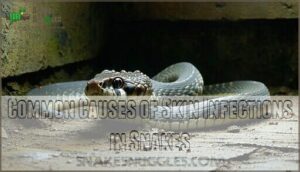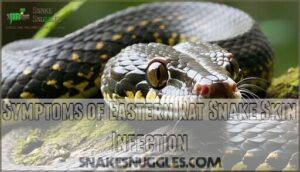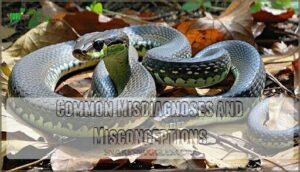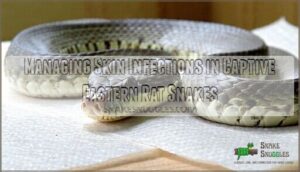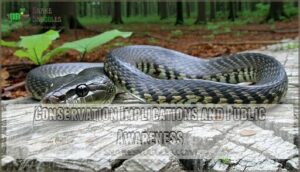This site is supported by our readers. We may earn a commission, at no cost to you, if you purchase through links.
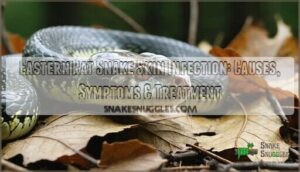
Snake Fungal Disease (SFD), caused by Ophidiomyces ophiodiicola, is the most common culprit, and poor humidity, dirty enclosures, and stress create the perfect storm for these infections to take hold.
You’ll need a vet’s diagnosis since bacterial infections can mimic fungal ones, and treatment typically involves antifungal medications and environmental improvements.
Think of it like athlete’s foot for snakes—uncomfortable and contagious, but treatable when caught early, and understanding why these infections develop and how proper care can prevent them entirely is key.
Table Of Contents
- Key Takeaways
- Identifying Eastern Rat Snake Skin Infection
- Causes of Skin Infections in Eastern Rat Snakes
- Snake Fungal Disease (SFD) in Eastern Rat Snakes
- Treatment and Management of Eastern Rat Snake Skin Infections
- Preventing Skin Infections in Eastern Rat Snakes
- Complications and Secondary Infections
- Common Misdiagnoses and Misconceptions
- Emerging Research and Future Directions
- Managing Skin Infections in Captive Eastern Rat Snakes
- Conservation Implications and Public Awareness
- Frequently Asked Questions (FAQs)
- How do you know if a rat snake has fungal disease?
- Are rat snakes susceptible to ophiodiicola infection?
- Do snakes have skin infections?
- What is snake fungal disease?
- Do rattlesnakes have snake fungal disease?
- What happens if a snake gets fungus?
- What does snake fungal disease look like?
- How to treat fungal infections in snakes?
- Is snake fungal disease contagious to humans?
- Do snakes carry diseases on their skin?
- Conclusion
Key Takeaways
- Watch for crusty, yellowish-brown skin lesions and facial swelling – these are telltale signs of Snake Fungal Disease (SFD) that you’ll need to catch early for successful treatment.
- Get a proper vet diagnosis before treating – bacterial and fungal infections look similar, so you cannot rely on visual symptoms alone to determine the right medication.
- Focus on prevention through clean enclosures and proper humidity – maintaining 50-60% humidity, weekly cleaning, and fresh substrates will stop most infections before they start.
- Expect a long recovery process with antifungal medications – treatment typically takes 4+ weeks and requires isolation, supportive care, and close monitoring to prevent secondary infections.
Identifying Eastern Rat Snake Skin Infection
When you notice unusual spots, swelling, or crusty patches on your eastern rat snake’s skin, you’re likely dealing with a skin infection that needs immediate attention.
Early identification can mean the difference between a quick recovery and a serious health crisis that threatens your snake’s life.
Common Causes of Skin Infections in Snakes
Eastern rat snake skin infections stem from several interconnected factors that create perfect conditions for bacterial and fungal invaders.
Snake skin infection develops when your reptile’s defenses weaken, allowing harmful organisms to establish themselves. Poor environmental conditions—like excessive humidity or inadequate temperature—stress your eastern rat snake’s immune system. Bacterial exposure through contaminated substrates, dirty water, or unclean enclosures provides pathogens direct access to vulnerable skin.
Common infection triggers include:
- Trauma wounds from rough handling or sharp enclosure edges
- Ectoparasites like mites that damage protective skin barriers
- Poor shedding cycles that leave retained skin vulnerable to scale rot
Snake fungal disease poses the greatest threat, with Ophidiomyces ophiodiicola thriving in damp conditions. This reptile skin infection spreads rapidly through contaminated soil and direct contact, making prevention your best defense against serious snake fungal infection.
Symptoms of Eastern Rat Snake Skin Infection
Your snake’s health depends on catching these warning signs early.
Look for thickened, crusted skin lesions that appear yellowish or brown, plus facial swelling and abnormal molting patterns.
| Physical Signs | Behavioral Signs |
|---|---|
| Skin discoloration and crusting | Reduced appetite |
| Eye cloudiness or opacity | Increased basking time |
| Nodules under skin surface | Lethargy or weakness |
| Facial swelling and disfiguration | Difficulty moving |
| Abnormal shedding patterns | Hiding more frequently |
Watch for these eastern rat snake symptoms – they’re your first clue something’s wrong.
Importance of Early Detection and Treatment
Early detection of eastern rat snake skin infection dramatically improves treatment efficacy and long-term outcomes.
You’ll want to monitor progress closely—catching snake fungal infection symptoms early means your preventative measures actually work.
Think of it like spotting a leak before your ceiling caves in!
Regular monitoring helps identify rat snake disease before it becomes life-threatening, giving your snake the best shot at recovery.
Causes of Skin Infections in Eastern Rat Snakes
Understanding what causes skin infections in your Eastern rat snake can help you prevent these serious health issues before they start.
You’ll find that environmental conditions, hygiene problems, and nutritional gaps are the main culprits behind most skin infections in these beautiful serpents.
Environmental Factors Contributing to Skin Infections
Your eastern rat snake’s environment plays a bigger role in skin health than you might think.
Several environmental factors can turn your snake’s home into a breeding ground for infections, making prevention your best defense strategy.
- Humidity levels: Too high creates fungal paradise; too low causes shedding problems
- Wet conditions: Standing water and poor drainage invite Ophidiomyces ophiodiicola growth
- Soil contamination: Dirty substrates harbor pathogens that cause snake skin infection
- Climate change: Altered temperatures disrupt natural microclimate balance
- Habitat degradation: Poor hygiene and cramped spaces stress your snake’s immune system
Role of Poor Hygiene and Overcrowding in Snake Enclosures
When overcrowding stress meets poor hygiene protocols, you’ve basically created a disease buffet.
Cramped quarters amplify disease amplification risks, turning minor environmental factors into major snake skin infection threats.
Dirty substrates harbor snake fungal disease spores while stressed snakes develop weakened immunity.
Regular cleaning is essential for preventing harmful buildups.
Smart enclosure sanitation and adequate space serve as your best preventative measures against infectious disasters.
Nutritional Deficiencies and Skin Infections in Eastern Rat Snakes
Poor nutrition compromises your eastern rat snake’s immune system, making skin infections more likely.
Dietary Imbalances and Vitamin Deficiencies lead to Immune Suppression and Shedding Problems, disrupting the Gut Microbiome.
Proper nutritional deficiencies prevention supports rat snake health:
- Adequate protein for tissue repair
- Calcium for strong scales
- Essential vitamins A and D
- Proper feeding frequency
- Species-appropriate prey size
Balanced nutrition strengthens your eastern rat snake against snake skin infection.
Snake Fungal Disease (SFD) in Eastern Rat Snakes
If you’ve noticed unusual skin changes on your Eastern rat snake, you might be dealing with Snake Fungal Disease (SFD), a serious condition that’s been spreading across North America since 2006.
This emerging threat, caused by the fungus Ophidiomyces ophiodiicola, can turn a healthy snake into a struggling patient faster than you’d expect, highlighting the serious nature of the condition.
Ophidiomyces Ophiodiicola: The Fungus Causing SFD
Most snake fungal disease cases stem from Ophidiomyces ophiodiicola, a sneaky pathogen with remarkable Environmental Persistence.
This fungus survives in soil using asexual Reproduction Mechanisms, creating whitish colonies with distinct odors.
Its Fungal Morphology includes septate hyphae and smooth conidia.
Understanding Virulence Factors helps explain why this eastern rat snake nemesis causes such devastating snake skin infections through limited Genetic Diversity.
The disease poses a threat to snake populations across North America.
Transmission and Incubation Period of SFD
Understanding Ophidiomyces ophiodiicola sets the stage for grasping how this sneaky fungus spreads.
Environmental reservoirs like contaminated soil act as transmission vectors, allowing contact transmission through infected surfaces or asymptomatic carriers.
You’ll notice incubation factors vary—symptoms appear within 12-37 days after exposure to these persistent fungal pathogens.
The fungus, first identified in 2008, has now affected many snake species.
Laboratory Diagnosis and Confirmation of SFD
Once you’ve spotted suspicious lesions, laboratory diagnosis becomes your detective work.
PCR testing and histopathology confirm ophidiomyces ophiodiicola presence through sample collection from affected skin.
Molecular diagnostics provide diagnostic accuracy that visual inspection can’t match, turning guesswork into scientific certainty for snake fungal disease SFD cases.
Treatment and Management of Eastern Rat Snake Skin Infections
When treating eastern rat snake skin infections, you’ll need to act quickly since early intervention substantially improves your snake’s chances of recovery.
The good news is that with proper antifungal medications, supportive care, and isolation protocols, most snakes can beat these stubborn infections—though it’ll take patience and dedication on your part.
Topical and Systemic Antifungal Medications for SFD
Medication timing is vital—terbinafine efficacy shines through nebulization therapy, delivering antifungal medications directly to affected areas.
However, resistance development poses challenges with systemic and topical treatments.
Implant administration offers sustained release, though medication side-effects require monitoring.
Combining approaches maximizes snake skin treatment success against snake fungal disease SFD, but antifungal medications aren’t magic bullets—patience and veterinary guidance are essential.
Surgical Treatment of Skin Lesions and Infections
When antifungal medications aren’t enough, surgical intervention becomes your next line of defense.
Your vet will perform lesion excision and debridement techniques to remove infected tissue under anesthesia, minimizing anesthesia risks through careful monitoring.
Surgical treatment options include:
- Grafting options for extensive tissue loss
- Targeted removal of abscesses and necrotic areas
- Post-op care with wound irrigation and antibiotics
- Recovery monitoring for snake skin lesions healing
This snake veterinary care approach gives your snake the best shot at complete recovery.
Importance of Providing Thermal, Fluid, and Nutritional Support
Beyond surgical intervention, your eastern rat snake needs thorough recovery support.
Think of it like nursing a friend back to health—warmth, water, and good food work wonders.
A vital aspect involves providing consistent heat sources to maintain ideal health.
Thermal regulation keeps their immune system firing on all cylinders, while hydration strategies flush toxins from their system.
Proper nutritional support and appetite stimulation help combat deficiencies that weaken recovery, which is a vital aspect of their care, ensuring they receive consistent heat sources, and benefit from thermal regulation and proper nutritional support.
Quarantine and Isolation Procedures for Infected Snakes
Alongside nutritional support, you’ll need proper quarantine duration of 30-60 days for your eastern rat snake.
Create a separate isolation environment away from healthy snakes to prevent cross-contamination risks.
Follow strict handling protocols using dedicated tools and gloves.
Implement daily monitoring procedures to track healing progress.
| Quarantine Phase | Duration | Key Actions |
|---|---|---|
| Initial Isolation | Days 1-14 | Separate enclosure, minimal handling, document symptoms |
| Treatment Phase | Days 15-45 | Administer medications, clean lesions, monitor appetite |
| Recovery Watch | Days 46-60 | Gradual reintroduction prep, final health checks |
| Post-Recovery | Ongoing | Regular monitoring, maintain biosecurity protocols |
Preventing Skin Infections in Eastern Rat Snakes
You can prevent most skin infections in your Eastern rat snake by maintaining clean living conditions and proper care routines.
Think of it like keeping your own home tidy – a clean environment stops problems before they start, saving you from dealing with sick snakes later.
Best Practices for Snake Enclosure Cleaning and Disinfection
Creating a spotless enclosure cleaning routine prevents nasty skin infections from taking hold.
Weekly disinfection with reptile-safe cleaners, plus fresh substrate every month, keeps harmful fungi at bay.
Water bowl hygiene matters too—scrub weekly and refill with clean water.
Bioactive setups need gentler care, while disinfectant choices should target Ophidiomyces specifically.
To prevent the buildup of harmful pathogens, allow sufficient contact time when disinfecting.
Cleaning frequency increases during outbreaks, because best practices beat expensive vet bills every time.
Importance of Proper Nutrition and Hydration
Your snake’s diet directly impacts its ability to fight off skin infections. Think of proper nutrition and hydration as your snake’s personal bodyguard against disease.
- Nutrient Absorption: Feed age-appropriate prey to guarantee vitamins reach every scale
- Hydration Methods: Provide clean water bowls and maintain 50-60% humidity levels
- Immune Support: Consider calcium/vitamin D3 supplements during shedding cycles
Nutritional deficiencies weaken your snake’s natural defenses, making skin infections more likely. To address deficiencies, consider a snake vitamin supplement.
Reducing Stress and Providing a Suitable Environment
You’ll want to think of your eastern rat snake’s enclosure as their personal sanctuary—a place where stress melts away like ice on hot pavement. Thermal Gradients let your snake choose their perfect temperature spot, while Proper Humidity keeps their skin healthy and supple.
Enclosure Design promotes healthy behavior. Temperature encourages thermoregulation. Humidity Control prevents skin issues. Enrichment Items stimulates mental health.
Hiding Places offer essential retreats for stress reduction, while Enclosure Enrichment keeps minds sharp. Minimize Handling during vulnerable periods, maintain excellent hygiene, and guarantee proper temperature regulation. This suitable environment foundation prevents infections before they start.
Regular Veterinary Check-Ups and Health Monitoring
You’ll want early detection through regular veterinary checkups every 6-12 months for your eastern rat snake.
Preventative care beats treating advanced snake skin infections. Monitor weight, appetite, and shedding patterns between visits.
Veterinary expertise spots subtle snake health issues before they escalate. Consistent health monitoring and proper husbandry impact your snake’s long-term wellness substantially.
Complications and Secondary Infections
When your eastern rat snake’s skin infection worsens, you’re dealing with more than just surface problems—secondary bacterial infections can quickly turn a manageable situation into a life-threatening emergency.
These complications can spread throughout your snake’s body, causing sepsis, respiratory issues, and dramatic changes in behavior that’ll have you wondering if your scaly friend will ever be the same again, facing a potential life-threatening emergency.
Bacterial Infections and Sepsis in Eastern Rat Snakes
Beyond preventative care, bacterial origins can transform minor skin issues into life-threatening sepsis symptoms in your eastern rat snake.
When bacteria invade compromised skin, they’re like uninvited party crashers causing chaos.
Watch for these sepsis symptoms:
- Lethargy and loss of appetite
- Red discoloration on belly scales
- Open-mouth breathing patterns
Antibiotic resistance makes prevention your best defense against these serious snake health issues, particularly because it can lead to life-threatening conditions.
Respiratory and Systemic Complications of Skin Infections
Untreated bacterial infections from damaged skin can spiral into serious pneumonia risk and septicemia threat for your eastern rat snake.
When bacteria enter the bloodstream, immune suppression and organ damage follow quickly.
These respiratory complications make breathing labored, while systemic complications affect multiple body systems simultaneously.
Treatment challenges multiply as secondary infections overwhelm your snake’s defenses, turning manageable snake skin infection into life-threatening emergencies.
Impact of Skin Infections on Snake Behavior and Appetite
When your eastern rat snake develops a skin infection, you’ll notice dramatic behavioral shifts that signal distress.
Appetite loss becomes the first red flag—your snake refuses meals like a finicky teenager.
Basking changes occur as infected snakes seek extra warmth for comfort.
Reduced hunting activity follows, with stress response triggering lethargy.
These activity levels drop substantially during snake fungal infection episodes.
Preventing and Managing Secondary Infections
When your eastern rat snake develops skin infection complications, swift action prevents disaster from snowballing.
Secondary infections pack a serious punch, but smart preventative measures keep trouble at bay.
Here’s your game plan for bulletproof protection:
- Antibiotic therapy – Combat bacterial invaders before antibiotic resistance develops
- Meticulous wound care – Clean lesions daily with veterinary-approved solutions
- Immune support – Boost natural defenses with proper nutrition and supplements
- Probiotics – Restore healthy gut bacteria after antimicrobial treatment
- Environmental control – Maintain ideal humidity and temperature for healing
Early intervention stops snake fungal infection from triggering cascading health problems.
Common Misdiagnoses and Misconceptions
You might confuse snake fungal disease with bacterial infections, shedding problems, or even parasites since they can look surprisingly similar at first glance.
Getting an accurate lab diagnosis isn’t just helpful—it’s essential because treating the wrong condition can make your snake’s health worse instead of better.
Distinguishing SFD From Other Skin Infections and Conditions
When bacterial infections masquerade as snake fungal disease, you’re dealing with skin discoloration that tells different stories.
Scale rot shows red, pustule-filled lesions while SFD presents yellowish crusts.
Thermal burns create blistered patches, and mite infestation causes tiny puncture wounds.
Dysecdysis appears as stuck shed skin, unlike SFD’s thickened, necrotic areas that resist normal shedding cycles, which can be confused with skin discoloration.
Importance of Accurate Laboratory Diagnosis
Getting the right diagnosis isn’t just splitting hairs—it’s the difference between effective treatment and shooting in the dark.
When you suspect snake skin infection, laboratory diagnosis through PCR testing and histopathology accuracy becomes your best friend.
Here’s why molecular diagnostics matter for differential diagnosis:
- PCR Testing identifies specific pathogens like Ophidiomyces ophiodiicola with precision
- Histopathology Accuracy reveals tissue changes that confirm infection severity
- Early Detection prevents misdiagnoses that delay proper treatment
- Treatment Impact improves dramatically with correct identification
- Advances in Diagnostics reduce guesswork and improve outcomes
You can’t treat what you don’t properly identify.
Common Misconceptions About Snake Skin Infections
Don’t fall for myths about snake skin infection. SFD Exaggeration claims it’s always fatal, but many snakes recover with proper care.
Harmless Scale Damage from rough handling gets mistaken for disease. Natural Shedding problems aren’t infections.
Home Remedies like tea tree oil can worsen conditions. Species Immunity doesn’t exist—any snake can develop snake fungal disease.
These misdiagnoses and misconceptions about snake skin disease delay proper treatment.
Raising Awareness and Education on SFD and Skin Infections
You can become a champion for SFD awareness by educating others about snake fungal disease and eastern rat snake health.
Share knowledge about reptile skin problems through social media, community talks, or wildlife groups.
Responsible ownership practices and public education create ripple effects that support conservation impact and fuel research initiatives protecting our scaly neighbors.
Emerging Research and Future Directions
Scientists are making exciting breakthroughs in understanding and treating snake fungal disease, giving you hope for better outcomes in infected Eastern rat snakes.
You’ll soon benefit from improved diagnostic tools, more effective treatments, and stronger prevention strategies as researchers work together to tackle this growing threat.
Advances in Molecular Diagnostics for SFD
The latest PCR Advancements in Snake Fungal Disease diagnostics are revolutionizing how we detect Ophidiomyces ophiodiicola.
These Molecular Diagnostics breakthroughs enable Early Detection with remarkable precision, helping you catch infections before they become severe.
Revolutionary diagnostic tools include:
- Real-time qPCR assays targeting fungal DNA with 98% accuracy
- Genetic Sequencing for Strain Identification across eight clades
- Biomarker Discovery detecting asymptomatic carriers in healthy snakes
- Molecular Characterization improving Fungal Diagnostics sensitivity over traditional culture methods
Development of Effective Treatments and Preventative Measures
Researchers are advancing Novel Antifungals and Probiotic Therapies to combat snake fungal disease more effectively.
Environmental Control techniques help prevent outbreaks, while studies explore Genetic Resistance in snake populations.
Preventative Husbandry practices—proper enclosure maintenance, stress reduction, and regular health monitoring—remain your best defense.
These effective treatments and preventative measures offer hope for better reptile skin treatment outcomes.
Understanding Environmental Factors Contributing to SFD Outbreaks
Environmental factors create perfect storms for SFD outbreaks in eastern rat snakes. Climate Influence and Wet Conditions promote fungal growth, while Habitat Degradation forces snakes into contaminated areas.
Key contributors include:
- Soil Contamination from human activities spreading pathogens
- Poor substrate and hygiene in shared hibernacula
- Population Isolation reducing genetic diversity and resistance
Understanding these environmental factors helps predict where SFD strikes next. In addition, research is focused on examining disease prevalence to better understand outbreaks.
Collaborative Research Efforts and Conservation Initiatives
Scientists are tackling snake fungal disease through collaborative research that spans multiple institutions and countries.
You’ll see biosecurity measures being developed alongside management strategies to address population declines in eastern rat snakes.
These conservation efforts combine citizen science, data sharing, and public education to combat SFD’s global impact on vulnerable snake populations.
Managing Skin Infections in Captive Eastern Rat Snakes
Managing skin infections in captive Eastern rat snakes requires a proactive approach that combines prevention, proper husbandry, and swift intervention when problems arise.
You’ll need to master both the art of creating an infection-resistant environment and the science of treating affected snakes while minimizing their stress during recovery, which is a delicate balance of minimizing stress.
Strategies for Preventing Skin Infections in Captive Snakes
Enclosure Hygiene forms your first line of defense against reptile fungal disease in captive snakes. Clean surfaces weekly with diluted bleach to eliminate harmful pathogens that cause snake fungal disease.
- Quarantine Protocols: Isolate new snakes for 30 days before introducing them
- Nutritional Support: Provide calcium-rich prey items during snake skin shedding cycles
- Stress Reduction: Minimize handling and maintain consistent temperatures for rat snake care
- Regular Checkups: Schedule veterinary exams every six months for early detection
- Environmental Control: Keep humidity between 40-60% to prevent fungal growth
Think of prevention as insurance—it’s cheaper than treatment!
Best Practices for Handling and Restraining Infected Snakes
When you’ve prevented skin infections with proper care, handling infected snakes requires extra precautions.
Use handling tools like hooks and tubes for safe restraint and bite prevention.
Wear gloves to reduce zoonotic risks from snake fungal disease.
Handle gently to avoid minimizing stress during quarantine.
These best practices protect both you and your snake during handling practices.
Providing a Suitable Environment for Recovery
Transform your eastern rat snake’s space into a healing haven by optimizing key environmental factors.
Create thermal gradients with basking spots reaching 85-88°F, maintain proper humidity control around 50-60%, and provide secure hiding places using appropriate substrate choice like cypress mulch.
Snakes benefit from having a dedicated basking area for thermoregulation.
- Temperature zones: Establish warm and cool areas for thermoregulation
- Moisture management: Monitor humidity levels to prevent further skin issues
- Stress reduction: Offer multiple retreats and minimize disturbances
This suitable environment promotes faster recovery while keeping your scaly patient comfortable during treatment.
Monitoring and Managing Stress in Captive Snakes
After creating your snake’s recovery environment, you’ll need to watch for stress signals that can worsen skin infections.
Behavioral monitoring helps spot issues early – look for excessive hiding, appetite changes, or restlessness.
Enclosure enrichment like branches and hiding spots reduces anxiety.
Gentle handling techniques during treatment prevent additional stress.
Quarantine protocols minimize disturbances while nutritional stressors from poor diet can compromise healing.
Remember, stressed captive snakes recover slower from snake fungal disease.
Conservation Implications and Public Awareness
When SFD strikes eastern rat snake populations, you’re witnessing a conservation crisis that threatens these important predators across their range.
Understanding this disease isn’t just about individual snakes—it’s about protecting entire ecosystems where these remarkable reptiles help control rodent populations and maintain ecological balance, which is a critical aspect of conservation.
Impact of SFD on Eastern Rat Snake Populations
Eastern rat snake populations face serious threats from snake fungal disease, caused by ophidiomyces ophiodiicola.
This pathogen drives population decline through devastating mortality rates reaching 90% in some outbreaks.
You’ll find conservation efforts targeting habitat loss while genetic diversity suffers in isolated groups.
The ecosystem effects ripple outward when these important predators disappear.
Key impacts include:
- Mortality rates up to 90% in affected populations
- Reduced reproduction and foraging success in survivors
- Increased vulnerability in fragmented habitats with low genetic diversity
- Compound threats when combined with existing habitat loss pressures
- Potential local extinctions in small, isolated snake populations
Raising Public Awareness About SFD and Snake Conservation
You’re building something bigger than just helping one snake—you’re becoming part of a movement.
SFD education starts with conversations in your community about snake fungal disease risks.
Support conservation funding through donations to wildlife organizations focusing on snake conservation.
Practice responsible ownership by following proper hygiene protocols.
Join citizen science projects that monitor local snake populations.
Advocate for habitat protection policies that reduce environmental stressors contributing to disease outbreaks.
Collaborative Conservation Efforts and Research Initiatives
Successful conservation efforts depend on robust collaborative efforts between researchers, wildlife agencies, and communities.
Data sharing networks accelerate wildlife research on snake fungal disease, while genetic research reveals population vulnerabilities.
Citizen science programs engage volunteers in monitoring, and strategic funding allocation supports habitat preservation.
These conservation initiatives create a safety net for Eastern Rat Snakes.
Promoting Responsible Snake Ownership and Handling Practices
Responsible eastern rat snake ownership begins with proper preparation and commitment.
Safe handling techniques and ethical sourcing from reputable breeders protect both snakes and wild populations.
- Implement biosecurity protocols – quarantine new snakes and disinfect equipment between handling sessions
- Create enrichment activities – provide hiding spots and climbing opportunities that mimic natural habitats
- Practice community education – share knowledge about snake skin conditions and responsible ownership with fellow enthusiasts
- Master handling practices – support your snake’s body properly and recognize early signs of illness
Frequently Asked Questions (FAQs)
How do you know if a rat snake has fungal disease?
Like something from a medieval bestiary, you’ll spot fungal disease through thickened, crusty skin lesions that appear yellowish or brown.
Look for facial swelling, ulcerations, abnormal shedding, and cloudy eyes—telltale signs trouble’s brewing.
Are rat snakes susceptible to ophiodiicola infection?
Yes, eastern rat snakes are definitely susceptible to Ophidiomyces ophiodiicola infection.
This fungus causes Snake Fungal Disease and has been confirmed in numerous snake species, including rat snakes, across 23 U.S. states.
Do snakes have skin infections?
Snake Fungal Disease affects 23 U.S. states, proving snakes definitely get skin infections.
You’ll spot thickened, crusty skin, ulcers, and facial swelling in infected snakes.
It’s caused by Ophidiomyces ophiodiicola fungus.
What is snake fungal disease?
You’ll encounter snake fungal disease when wild snakes get infected by Ophidiomyces ophiodiicola, a nasty fungus that creates crusty skin lesions, facial swelling, and ulcerations that can kill them.
Do rattlesnakes have snake fungal disease?
Rattlesnakes actually helped put snake fungal disease on the scientific map when researchers first documented this nasty condition in You’ll find timber rattlesnakes and massasaugas particularly vulnerable to infections.
What happens if a snake gets fungus?
When your snake gets fungal disease, it’ll develop thickened, crusty skin lesions and facial swelling.
You’ll notice abnormal shedding, ulceration, and behavioral changes like increased basking, which can lead to death without treatment.
What does snake fungal disease look like?
You’ll notice telltale signs like crusty, thickened skin patches that look yellowish or brown.
These unsightly lesions often appear as scabs, blistered scales, or unusual nodules beneath the surface, creating a rough texture you can’t miss, with thickened skin patches being a common indicator.
How to treat fungal infections in snakes?
You’ll need antifungal medications like terbinafine, either as implants or nebulization treatments.
Provide supportive care with proper heating, nutrition, and wound management.
Expect recovery to take four-plus weeks with veterinary guidance.
Is snake fungal disease contagious to humans?
Rest easy—this fungal nightmare won’t jump from your scaly friend to you. Snake fungal disease stays in the reptile world, so you’re safe from catching Ophidiomyces ophiodiicola through handling.
Do snakes carry diseases on their skin?
Yes, snakes can carry various pathogens on their skin, including bacteria, fungi, and parasites. Snake Fungal Disease, caused by Ophidiomyces ophiodiicola, creates visible lesions but doesn’t typically infect humans.
Conclusion
Successfully treating an eastern rat snake skin infection is like winning a battle against an invisible enemy—it requires the right weapons and strategy.
You’ve learned that early detection, proper veterinary care, and environmental improvements are your best defense against these stubborn infections.
Remember, an ounce of prevention beats a pound of cure, so maintain clean enclosures, proper humidity, and regular health checks to keep your snake infection-free and thriving, which is the ultimate goal of providing a healthy environment and ensuring your snake is infection-free.
- https://royalsocietypublishing.org/doi/10.1098/rstb.2015.0457
- https://pmc.ncbi.nlm.nih.gov/articles/PMC5095536/
- https://parcplace.org/wp-content/uploads/2022/06/WFP-Fact-Sheet%E2%80%93Ophidiomycosis_3.pdf
- https://www.gardenwildlifehealth.org/portfolio/snake-fungal-disease/
- https://dep.nj.gov/njfw/wp-content/uploads/njfw/snake_fungal_disease.pdf

